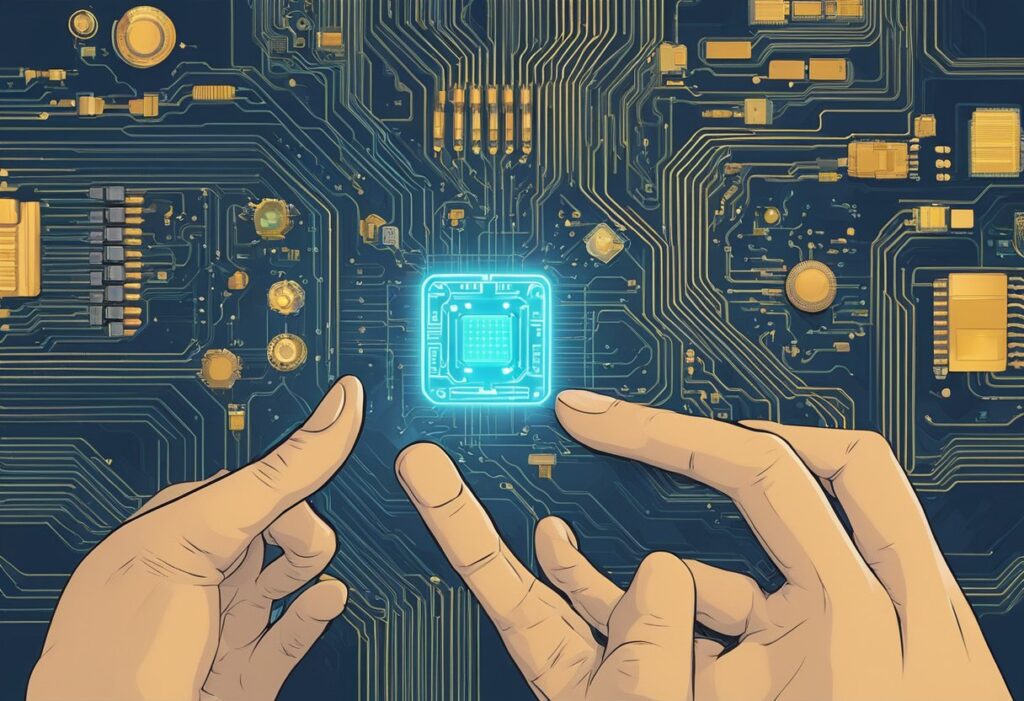The concept of the metaverse has been gaining traction in recent years, with companies such as Facebook and Meta investing heavily in its development. The metaverse is essentially a virtual world where users can interact with each other and digital objects in a way that feels immersive and real. In this blog post, we will explore the concept of metaverse chip implant, what it is, how it will work and potential dangers.
One of the ways in which the metaverse could be accessed in the future is through chip implants. Companies like Neuralink, founded by Elon Musk, are already working on developing implantable chips that allow users to control computers and mobile devices with their minds. In a recent interview, Musk even suggested that the Neuralink chip could be used to put users in full virtual reality, which would beat Meta’s plan to use VR headsets to access the metaverse.
While the idea of a metaverse chip implant may seem like something out of science fiction, it could become a reality sooner than we think. As technology continues to advance, it’s possible that we may see a future where users can access the metaverse without the need for external devices like headsets or controllers.
However, there are also concerns about the potential risks and ethical implications of implantable technology, which will need to be carefully considered and addressed.
The Concept of Metaverse and Implants
Metaverse is the next-generation internet that allows people to interact with each other through three-dimensional avatars.
The concept of metaverse chip implants is to enhance the experience of the user by providing a direct interface between the human brain and the virtual world. The implant can receive neural signals from the brain and translate them into actions in the virtual world.
How Chip Implants Interact with the Human Brain
The chip implant technology works by interfacing with the neurons in the brain. The implant is designed to receive and decode neural signals from the brain, which are then translated into actions in the virtual world. The implant can also send signals back to the brain, creating a two-way communication channel between the brain and the virtual world.
The technology is still in its early stages, and there are concerns about the long-term effects of the implant on the brain. However, researchers are working to ensure that the technology is safe and effective for use in humans.
The Role of AR and VR in Chip Implant Technology
Augmented Reality (AR) and Virtual Reality (VR) are vital components of the metaverse chip implant technology. AR and VR provide the immersive experience that is required for the user to interact with the virtual world. The chip implant technology enhances the experience by providing a direct interface between the user’s brain and the virtual world.
The metaverse chip implant technology is an exciting development that has the potential to revolutionize the way we interact with the virtual world. The technology is still in its early stages, but researchers are working to ensure that it is safe and effective for use in humans.
With the continued development of AR and VR, the metaverse chip implant technology has the potential to provide a truly immersive experience for the user.
Technological Foundations of Chip Implants

Advancements in AI and Its Integration
Chip implants for the metaverse rely heavily on artificial intelligence (AI) for their functionality. AI has advanced significantly in recent years, making it possible to create more sophisticated and intelligent systems. These systems are capable of analyzing, interpreting, and responding to complex data in real-time.
The integration of AI with chip implants allows for the collection and interpretation of data from the human brain. This data can be used to control various aspects of the metaverse, such as virtual avatars and environments. The use of AI in chip implants also enables the development of more intuitive and responsive brain-computer interfaces (BCIs).
Semiconductors and Electronics in Implants
Chip implants for the metaverse require the use of semiconductors and electronics for their operation. Semiconductors are used to create the microchips that are implanted in the brain. These microchips contain sensors that can detect and interpret neural activity.
Electronics are used to power and control the microchips. They are also used to transmit data from the microchips to external devices. The use of advanced semiconductors and electronics in chip implants allows for more accurate and reliable data collection and transmission.
Battery and Energy Solutions for Sustained Performance
Chip implants for the metaverse require a reliable and sustainable source of power. The use of advanced batteries and energy solutions is essential for the sustained performance of these implants.
The batteries used in chip implants must be small, lightweight, and long-lasting. They must also be capable of withstanding the harsh conditions of the human body. Energy solutions such as wireless charging and energy harvesting can also be used to extend the battery life of these implants.
The development of chip implants for the metaverse is an exciting and rapidly evolving field. Companies such as Neuralink are leading the way in the development of advanced chip implants that can interface with the human brain. The technological foundations of these implants, including advancements in AI, semiconductors, and battery and energy solutions, are essential for their success.
The Ecosystem and Industry Impact
The metaverse chip implant is set to revolutionize the way we interact with the digital world. It is expected to have a significant impact on the technology ecosystem and various industries.
Key Vendors and Companies Leading the Way
Several companies are leading the way in developing and implementing metaverse chip implants. Facebook, Microsoft, and Elon Musk’s Neuralink are among the top players in this field. Facebook’s CEO, Mark Zuckerberg, has been vocal about his company’s vision for the metaverse and has invested heavily in this technology.
Impact on Social Media and Digital Communication
The metaverse chip implant is expected to have a significant impact on social media and digital communication. It will allow for seamless integration between the physical and digital worlds, enabling users to interact with each other in new and exciting ways.
Social media platforms such as Facebook and Twitter are already exploring the potential of the metaverse and are expected to be key players in this space.
Gaming, Entertainment, and the Metaverse Experience
The gaming and entertainment industry is expected to be one of the biggest beneficiaries of the metaverse chip implant. It will allow for a more immersive and interactive gaming experience, enabling players to fully immerse themselves in virtual worlds. The metaverse chip implant is also expected to revolutionize the way we consume entertainment, enabling us to experience movies, music, and other forms of media in new and exciting ways.
The metaverse chip implant is set to have a significant impact on the technology ecosystem and various industries. It will enable us to interact with the digital world in new and exciting ways, revolutionizing the way we communicate, work, and play.
Practical Applications and Future Possibilities
The Metaverse chip implant has the potential to revolutionize various industries and fields, from healthcare to everyday devices. Here are some practical applications and future possibilities of the Metaverse chip implant:
Healthcare Innovations with Surgical Robots and Implants
The Metaverse chip implant can be used in the healthcare industry to improve surgical procedures and patient outcomes.
With the help of surgical robots, doctors can use the chip to enhance their precision and control during surgeries. The chip can also be used to monitor patients’ vital signs and health data in real-time, allowing for more accurate diagnoses and personalized treatment plans.
Enhancing Everyday Devices: Cars, Phones, and Gadgets
The Metaverse chip implant can be used to enhance everyday devices such as cars, phones, and gadgets. By integrating the chip into these devices, users can experience a more immersive and interactive digital environment. For example, the chip can be used to create mixed reality environments that blend the physical and digital worlds seamlessly.
Creating Digital Twins and Mixed Reality Environments
The Metaverse chip implant can be used to create digital twins of real-world objects and infrastructure. This technology has the potential to revolutionize the way we design, build, and maintain physical structures such as factories, power grids, and transportation systems. By creating digital twins, engineers and designers can simulate and test various scenarios before implementing them in the real world.
The Metaverse chip implant has the potential to revolutionize various industries and fields, from healthcare to everyday devices. With the ability to create digital twins and mixed reality environments, the chip has the potential to transform the way we design, build, and maintain physical structures. With the help of surgical robots, doctors can use the chip to improve surgical procedures and patient outcomes.

User Experience and Societal Considerations
The use of neural implants for accessing and interacting with the metaverse has the potential to revolutionize the way people experience virtual reality. However, it also raises important privacy and ethical concerns. In this section, we will discuss these concerns and explore potential solutions.
Addressing Privacy and Ethical Concerns
One of the primary concerns with neural implants is the potential for unauthorized access to personal data. To address this issue, it is essential to implement robust security measures that protect users’ privacy. This can include encryption of data, user authentication, and secure storage of information.
Ethical concerns arise when considering the use of neural implants. It is important to ensure that the use of these devices is voluntary and that users are fully informed of the risks and benefits. It is also important to consider the potential impact on vulnerable populations, such as children and individuals with disabilities.
Tackling Challenges: Motion Sickness and User Help
Another challenge associated with using neural implants for the metaverse is the potential for motion sickness. This can be addressed by implementing measures such as limiting the field of view, reducing latency, and providing users with visual cues to help them maintain their balance.
User help is another important consideration when it comes to the use of neural implants. It is essential to provide users with the necessary support and assistance to ensure that they can use the technology effectively. This can include providing user manuals, tutorials, and technical support.
Memory and Cognitive Effects of Neural Implants
Finally, it is important to consider the potential effects of neural implants on memory and cognitive function. While these devices have the potential to enhance cognitive abilities, they may also have unintended consequences. It is essential to conduct further research to fully understand the impact of neural implants on memory and cognitive function.
While neural implants have the potential to revolutionize the way people experience the metaverse, it is essential to address privacy and ethical concerns, tackle challenges such as motion sickness and user help, and consider the potential effects on memory and cognitive function. By doing so, we can ensure that the use of these devices is safe and beneficial for all users.

Frequently Asked Questions
What does the Neuralink implant do?
The Neuralink implant is a brain-computer interface that allows for the direct communication between the human brain and a computer. The implant consists of a small chip that is implanted into the brain and is capable of reading and interpreting the electrical signals that are generated by the neurons in the brain.
What is the name of Elon Musk’s brain chip?
The name of Elon Musk’s brain chip is Neuralink.
How much does Neuralink cost?
The cost of Neuralink is not publicly available yet.
What is the risk of Neuralink?
There are risks associated with any surgical procedure, including the implantation of the Neuralink chip. The risks associated with the Neuralink implant include infection, bleeding, and damage to the brain tissue. However, the risks associated with the Neuralink implant are considered to be relatively low.
What are the potential benefits and drawbacks of brain-computer interface implants?
The potential benefits of brain-computer interface implants include the ability to restore lost motor function, improve communication for individuals with speech and language disorders, and the ability to control devices using thought alone.
The potential drawbacks of brain-computer interface implants include the risk of infection, the possibility of the implant malfunctioning, and the potential for the technology to be used for nefarious purposes.
How much is the estimated cost for a brain-computer interface implant?
The estimated cost for a brain-computer interface implant is not currently publicly available.
When is the expected public availability of brain-computer interface technology?
The expected public availability of brain-computer interface technology is not currently known.
What medical conditions might brain-computer interface implants be able to treat or alleviate?
Brain-computer interface implants have the potential to treat or alleviate a variety of medical conditions, including paralysis, stroke, and certain types of brain injuries.
What progress has been made in human trials for brain-computer interface systems?
There has been significant progress in human trials for brain-computer interface systems. Several companies, including Neuralink, have conducted successful human trials, demonstrating the potential of this technology.
What are the safety concerns associated with brain-computer interface implants?
The safety concerns associated with brain-computer interface implants include the risk of infection, the possibility of the implant malfunctioning, and the potential for the technology to be used for nefarious purposes. However, the risks associated with brain-computer interface implants are considered to be relatively low.














